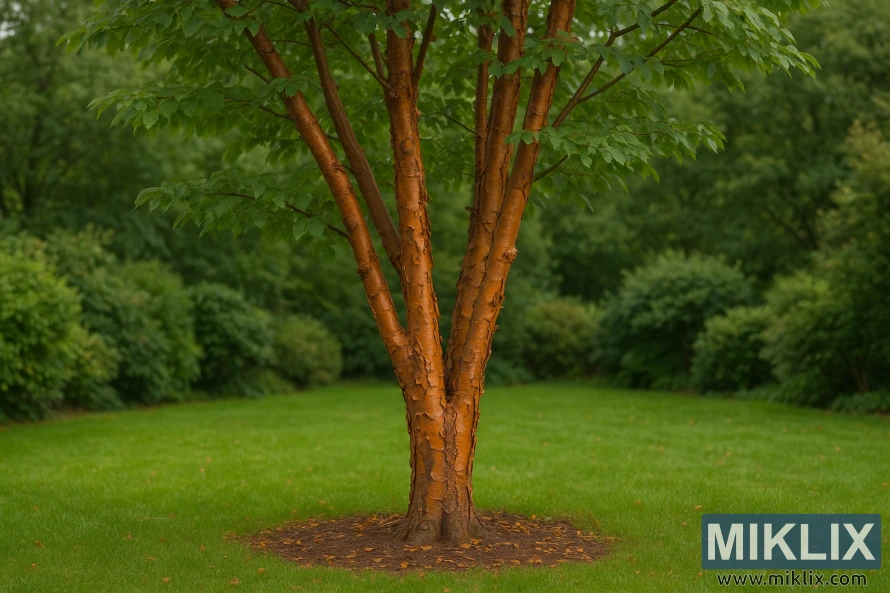Image: Paperbark Maple in Garden
Published: August 22, 2025 at 9:07:54 AM UTC
Last updated: September 28, 2025 at 8:23:09 AM UTC
A Paperbark Maple with peeling cinnamon bark and lush green canopy stands elegantly in a verdant garden, prized for its ornamental beauty.
Amidst the serene greenery of a carefully maintained garden, a remarkable Paperbark Maple (Acer griseum) rises with quiet dignity, its elegant form defined as much by its unusual bark as by the graceful sweep of its branches. Unlike many trees whose summer charm lies primarily in their foliage, this specimen captivates the eye with the rich, cinnamon-colored bark that peels naturally away from its trunk and stems in delicate, curling layers. These papery strips, hanging lightly or curling back upon themselves, create a textured surface that catches the light in countless subtle ways. Sunlight and shadow play across the bark, producing warm tones of copper, russet, and bronze that glow against the lush backdrop of green lawn and distant shrubs. This bark is more than just an ornamental feature—it is the very character of the Paperbark Maple, ensuring it remains a point of fascination throughout the seasons.
The tree emerges from the ground in a cluster of stems, each rising confidently and diverging upward in slightly different directions, lending the whole composition a sculptural quality. These multiple trunks, smooth in some places and rugged in others, are unified by their signature peeling bark, which reveals lighter hues beneath as the outer layers curl away. The effect is a striking contrast between the living structure of the tree and the ephemeral quality of the bark that seems perpetually in the process of renewal. At the base, the soil and grass form a clean, circular boundary, as though the tree has been purposefully framed to showcase its ornamental features.
Above the sculptural trunks, a canopy of fresh green foliage spreads in gentle layers. The leaves, small and trifoliate, offer a delicate counterpoint to the robustness of the bark, softening the tree’s overall appearance. Their cool green tones harmonize with the surrounding landscape, blending into the garden while simultaneously framing the richly colored stems. This interplay of bark and foliage heightens the visual appeal, for while the leaves provide seasonal shade and texture, the bark remains the enduring centerpiece, visible and engaging even when the tree is bare in winter.
The background of dense, darker shrubs and blurred woodland adds depth to the scene, allowing the Paperbark Maple to stand out with clarity. Against this verdant backdrop, its coppery bark appears almost luminous, as if glowing from within. The surrounding garden’s simplicity enhances the maple’s uniqueness; there are no competing colors or bold structures, only a quiet landscape that allows the tree’s natural artistry to take center stage. This calm setting underscores why the Paperbark Maple is so prized: it is both understated and dramatic, an embodiment of refined beauty that never feels out of place, yet always draws the eye.
What makes this tree especially treasured in horticultural design is its year-round ornamental value. While its summer canopy offers shade and softness, autumn transforms the foliage into vibrant shades of orange and red, complementing the copper bark with a blaze of fiery color. In winter, after the last leaves have fallen, the bark becomes the star once more, its peeling, curling texture providing a rare visual interest in the dormant garden. Even in spring, the subtle emergence of new foliage against the warm bark creates an elegant balance that delights the observer. Thus, this Paperbark Maple is more than a seasonal marvel—it is a tree that rewards attention in every stage of the year.
In this garden, the Paperbark Maple does not overwhelm with sheer size or dominating presence. Instead, it commands admiration through detail, texture, and subtlety. Its layered bark invites closer inspection, its branching form offers sculptural intrigue, and its canopy provides seasonal shade and softness. It stands as both a living plant and a piece of natural art, reminding those who encounter it that beauty can be found not only in grandeur but also in intricacy. Here, in this verdant setting, the Paperbark Maple fulfills its role as one of the most distinctive and ornamental trees available, a specimen that blends refinement with resilience, and artistry with nature’s enduring cycles.
The image is related to: The Best Maple Trees to Plant in Your Garden: A Guide to Species Selection

